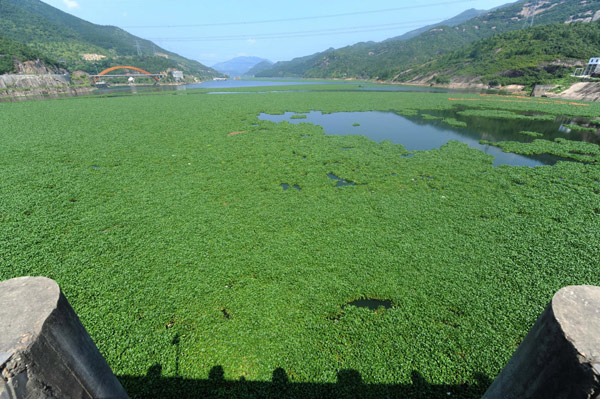Recent studies show the aquatic biodiversity of Kerala has been threatened by the invasive species, North African Catfish.
This species was introduced all over the world during the 1980s for aquaculture purposes. It has a survival edge over other fish species due to its ability to thrive in oxygen depleted and shallow muddy waters.
 North African catfish
North African catfish
What is an invasive species?
A species is termed invasive if it’s previously absent in that ecosystem and has been introduced in that area from outside mostly by human intervention. A common trait is the presence of some trait absent in local fauna or flora which enables it to have a competitive edge over the native species.
Other prominent cases in India in recent times.

Water Hyacinth covering vast portion of a waterbody
- Chilka Lake became degraded mainly through siltation and the choking of the seawater inlet channel, this resulted in the proliferation of invasive freshwater species, a decrease in fish productivity and an overall loss in biodiversity.
- Invasive growth of the grass Paspalum distichum has changed the ecological character of large areas of the Keoladeo National Park, reducing its suitability for certain waterbird species including the Siberian Crane.
- In the Kanjli Wetlands the water hyacinth which was introduced is now invasive. From time to time it is removed using mechanical means.
- At the Ropar wetlands invasive weeds are also a concern and management plans are under development.
Solutions already in Place.
- A Draft National Wetland Strategy has been developed with a clear focus on control of invasive species. Also, several initiatives have been undertaken under the Convention of BioDiversiy to control proliferation of invasive species in wetlands and other aquatic bodies.
- Management Action Plans(MAP) have been formulated for 30 out of 66 wetlands identified for conservation and sustainable use. These MAPs have a focus on biodiversity conservation and restoration of ecosystem processes and functions. One of the activities carried out in association with these plans is the control of alien invasive species.
- The threat of invasive pest species gaining entry into India (imported plant/planting material) is addressed under The Plant Quarantine (Regulation of Import into India)Order, 2003, under the ICAR. However, the risk analysis for invasiveness of a plant species per se is not taken care of under this order.
- The Ministry of Environment and Forests issues approval along with quarantine certificates for the export of wild animals and articles under the Wildlife (Protection) Act 1972.
- The Destructive Insects and Pests Act 1914 aims to prevent introductions into India, and the transport from one province to another, of any fungus or other pest which is, or may be destructive to crops
More Measures
As presently there is no exclusive legislation or policy in India to deal with the invasive alien species. Its necessary that robust steps are to be taken to face this menace. Possible actions include:
- Strengthening domestic quarantine measures to contain the spread of invasive species to neighbouring areas.
- Developing a national database on invasive alien species reported in India.
- Developing appropriate early warning and awareness system in response to new sightings of invasive alien species.
- Providing priority funding to basic research on managing invasive species.
Comments